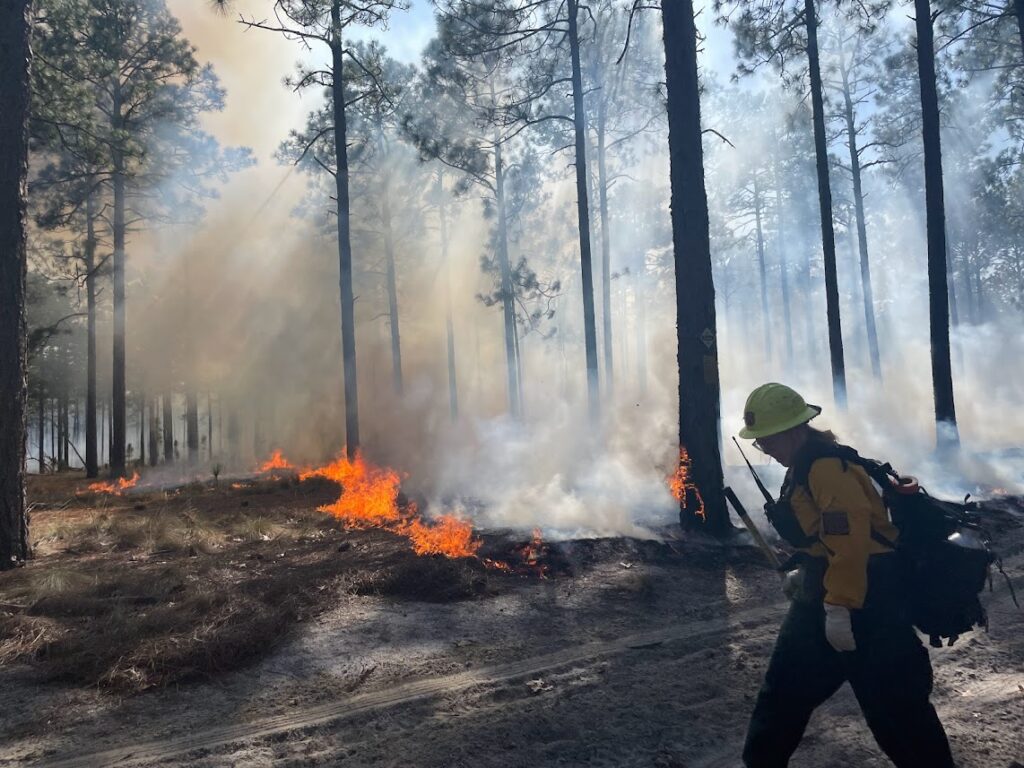Prescribed Fire in North Carolina
Photo Credit: Adam Warwick
Fire is an essential part of the North Carolina landscape. Prescribed fire ensures the health of our ecosystems, wildlife, and human communities.
For thousands of years, lightning strikes and intentional burning by Native Americans burned across what we now call North Carolina. These fires played important roles – improving habitats, reducing ticks and wildfire danger, and serving an important cultural purpose for Native Americans. Early European colonizers saw these benefits and began setting their own fires. But early in the 20th Century, fire was excluded from the landscape. Lightning strike fires were suppressed. Government policies called those who used fire backwards, stupid, and dangerous, and the number willing to risk burning their land dwindled. The forest suffered, and grasslands disappeared without fire to stop trees from taking them over. Today the North Carolina Prescribed Council is working to reverse that trend – bringing fire back to the land, which improves habitat as well as reducing the risk of damaging, out-of-control wildfires.

Scientists have mapped out this ancient history. They’ve used historical records, tree scars and rings, and carbon dating along with other factors such as topography and climate to determine that fire was a regular visitor to the Tarheel State. Most of the state burned every 4 to 6 years. Some places, such as the Sandhills longleaf pine forests burned every 1 to 3 years while others such as the mountains burned less frequently, every 12 years or so.
Many plants need fire to survive. Table Mountain pinecones are covered in wax; fire melts the wax, releasing its seeds. For other plants, fire removes competitors allowing them to thrive. Fire also improves habitat – providing places for ground birds to nest and ensuring a healthy crop of nuts and other food for a host of animals. People also benefit. Our forests are filled with fuel such as buildup of downed trees or shrubs. Low intensity fires remove that fuel in a controlled fashion, helping to reduce the chance of severe wildfires. Fire also helps reduce pests such as ticks that can cause serious diseases in humans.
Fire practitioners across the state are putting fire back to North Carolina. The prescribed burns, also known as controlled burns, are conducted safely. No fire is lit until experts on the ground have determined that the conditions are right to protect firefighters and nearby human communities.
That’s why the North Carolina Prescribed Fire Council is working to grow its ranks – increasing the number of trained individuals who can help create safe healthy forests for people and nature.
Want to learn more about prescribed fire in North Carolina? Check out these resources!
- Effects of Prescribed Fire and Wildfire: Frequently Asked Questions from North Carolina (Southern Fire Exchange) https://eadn-wc02-7111601.nxedge.io/wp-content/uploads/2012-5.pdf
- North Carolina Forest Service Prescribed Fire Information https://ncforestservice.gov/goodfire/index.htm
- The Role of Fire in the Forest (The Nature Conservancy North Carolina) https://www.nature.org/en-us/about-us/where-we-work/united-states/north-carolina/stories-in-north-carolina/fire-forests/
- NC State Extension Forestry Prescribed Fire Information, Publications, and Programs https://forestry.ces.ncsu.edu/prescribed-fire/
